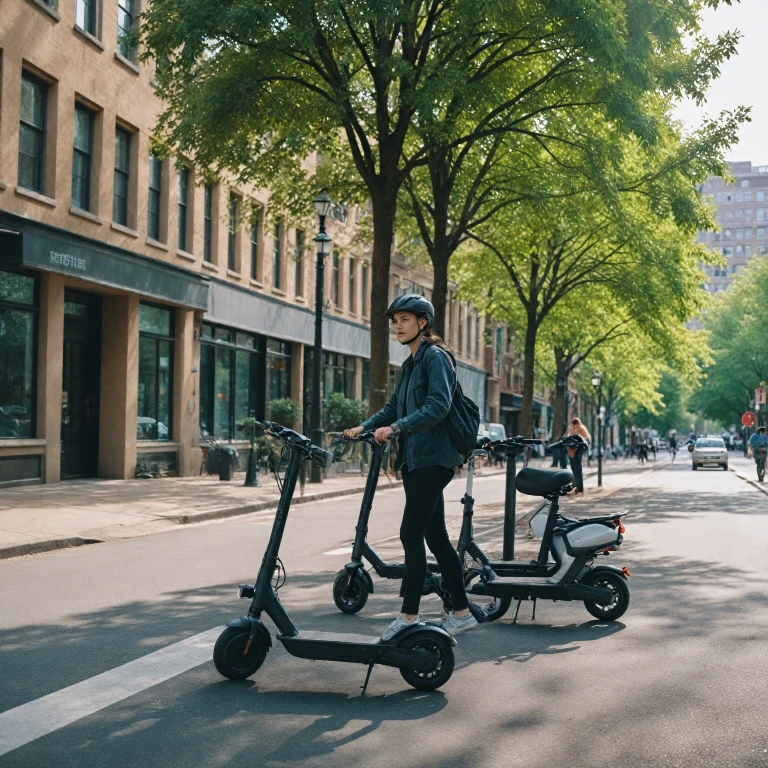Understanding the Basics: Ebike vs Scooter
Grasping the Key Differences
Diving into the world of electric mobility, it’s important to understand the core distinctions between an electric bike and an electric scooter. Both options offer flexible, eco-friendly transportation with their unique characteristics.
Electric bikes, often referred to as ebikes, bear a close resemblance to traditional bicycles. They typically feature a pedal assist system, which engages the electric motor to provide an extra boost as you pedal. This makes uphill rides or longer distances more manageable. Ebikes are designed for a blend of manual cycling and electric power, allowing riders to switch between different modes of speed and effort seamlessly.
On the other hand, electric scooters offer a stand-on design with handlebars for steering, generally operated by a throttle rather than pedaling. Scooters excel in ease of use and convenience, especially for shorter commutes across flat terrains. For those interested in a scooter bike hybrid, some models offer seating for increased comfort over longer distances.
When comparing these modes of transport, consider the typical riding context. Ebikes are suitable for those who enjoy a leisurely bike ride with added power, making them ideal for varied terrains. Electric scooters, however, are generally better suited for urban environments where quick, direct paths via bike lanes are prevalent. In terms of speed, both options can achieve similar ranges in mph, though exact limits depend on motor power and battery capacity.
Before making a purchase, take into account factors such as battery life, safety regulations, and personal comfort. The choice between an ebike and an electric scooter depends on how you plan to use the vehicle on a daily basis. To explore which option aligns with your commuting needs, consider checking out
finding the ideal commuter scooter.
Distance Capabilities and Speed Limits
When considering performance and range, both electric bikes and scooters offer unique advantages. Electric bikes, equipped with pedal assist features, typically provide a more extended range compared to electric scooters due to their larger battery capacity and efficient energy use. On average, an electric bike can reach ranges of 30-50 miles per charge, with some high-performance models going beyond this.
Electric scooters, on the other hand, usually have a more compact design and smaller batteries, which might limit their range to around 15-25 miles per charge. However, the efficiency of a scooter electric motor and its lighter weight make them easier to manage even when the battery is low.
Speed and Versatility
Speed is another crucial factor to consider. Electric scooters tend to reach a top speed of around 15-20 mph, suitable for city commuting and short trips. Meanwhile, electric bikes can vary significantly based on their motor power, with speeds ranging from 20 mph to 28 mph in more powerful models.
The type of rider you are and your travel needs will influence your choice. If you're navigating busy urban environments with bike lanes, electric scooters provide convenience and flexibility. In contrast, electric bikes might offer advantages for longer commutes or off-road paths, thanks to their mix of manual cycling options and electric assistance.
Motor Power and User Requirements
Power is crucial for both bikes and scooters, affecting speed, hill-climbing ability, and overall performance. Electric bikes often come with more powerful motors, providing an edge for distance riding and diverse terrains. Electric scooters, although typically equipped with less powerful motors, offer reliable speed and acceleration for city travel.
Keep in mind that certain regions might require a driver license for more powerful electric scooters due to their classification as mopeds. Before making a decision, it’s advisable to understand local regulations to ensure compliance and safety. For more detailed information, you can read about specific rules and regulations involving electric scooters in different areas, such as
this article on electric scooter regulations in Florida.
Cost Considerations: Budgeting for Your Ride
Budgeting Your Wheels
When it comes to budgeting for your ride, understanding the cost differences between ebikes and electric scooters is vital. The initial purchase price, ongoing maintenance, and potential need for a driver license are key factors to consider.
Ebikes, which are essentially electrically assisted bicycles, usually come with a higher initial cost than scooters. This is due to the added complexity of pedal assist systems and higher-capacity batteries, which contribute to an extended range and power. These bikes can typically travel longer distances, with some models reaching up to 100 miles on a single charge.
In contrast, electric scooters generally have a lower purchase price. They are often simpler in design and may have a more limited range, but they offer sufficient speed mph for urban commuting. While the initial investment is lower, potential riders should account for battery replacement costs and regular maintenance to keep scooters electric and safe for riding.
Maintenance needs for both bikes and scooters can affect costs. Electric bikes, with their pedal assist and more complex mechanics, might require more frequent servicing than their simpler scooter counterparts. Consider regular check-ups for the electric motor, battery health, and brakes.
Finally, don't forget the costs associated with regulations and safety. In some areas, using a powerful ebike or electric scooter on bike lanes might require additional safety gear or a driver license, affecting your overall budget. For more details on how motorized scooters fit into various regulations, what you need to know about safety, and tips for maximizing the battery lifespan,
click to expand your understanding.
Safety and Regulations: Staying Legal and Safe
Staying Legal and Safe on Your Ride
Safety and regulations are crucial considerations when choosing between an electric scooter and ebike. Compliance with local laws not only ensures your safety but also keeps you on the right side of the law. Regulations can vary significantly depending on your location, so let's explore the essentials for both ebikes and scooters.
- Licensing and Registration: Electric scooters often require a driver license for operation, especially higher-powered models. Conversely, electric bikes may be considered similar to traditional bicycles in many areas, allowing use without a driver license. However, certain classifications of ebikes could require a specific license or registration.
- Speed Limits: Typically, both ebikes and electric scooters are subject to speed limits. Ebikes often offer speeds up to around 15-30 mph, while scooters can vary more significantly based on the electric motor and model. Staying within these limits is necessary for legal road use.
- Where to Ride: Most places allow electric bikes in bike lanes, parks, and on roads, whereas electric scooters might be more restricted and could require the use of sidewalks or designated bike lanes. Always check your local regulations to know where your chosen vehicle can be legally ridden.
- Helmet Laws: Safety measures such as helmet usage are typically enforced for both ebikes and scooters, especially for younger riders. Some regions might mandate helmet use for all ages on certain motorized rides.
- Battery and Range Considerations: Safety isn't just about road rules; understanding the range and battery capacity of your scooter or ebike will help prevent unexpected stops that could lead to unsafe situations. With typical ranges varying from 15 to 50 miles, understanding the limitations of your ride is critical.
Being aware of the specific rules that apply to your electric scooter or ebike not only promotes safety but also enhances the overall riding experience, letting you enjoy your scooter bike or ebike responsibly. By staying informed, you ensure not only safety but also contribute to a smoother and more sustainable urban mobility solution.
Environmental Impact: Green Credentials
Evaluating Eco-Friendliness
When considering the environmental impact of electric scooters and bikes, it is essential to note their advantages over traditional gasoline-powered vehicles. Both electric scooters and ebikes can significantly reduce the carbon footprint of individuals who switch from cars to these more eco-conscious options.
For those pondering the environmental benefits, electric scooters typically utilize a rechargeable battery, allowing them to achieve a range of miles depending on speed and riding conditions. The absence of emissions during operation marks a clear advantage over motor-driven mopeds or cars.
Electric bikes share similar green credentials, particularly models equipped with a pedal assist feature. This allows riders to combine human power with electric motor efficiency, offering a sustainable alternative to both cars and manual bicycles.
Battery Disposal and Lifecycle
Despite the clear environmental benefits, both electric bikes and scooters do rely on batteries, which present their own set of environmental considerations. The production and disposal of these batteries come with environmental costs. However, advancements in battery recycling and extended lifecycle management are continuously being researched, aiming to mitigate these impacts.
The Carbon Trade-off
When assessing the carbon trade-off, one should consider the entire lifecycle of these devices. This includes manufacturing, transportation, and operational emissions. Electric scooters and bikes are poised as better options than gasoline-powered vehicles in terms of overall emissions, particularly when powered by sustainable electricity sources.
For urban riders, choosing between a bike and a scooter for daily commutes also involves considering infrastructure. The presence of bike electric lanes can influence which option offers a more practical and environmentally friendly ride. Each has its benefits; however, communities with more developed cycling infrastructure may find electric bikes a better fit.
Ultimately, the decision will hinge on personal priorities and local conditions. Both scooters electric and bikes electric bring significant environmental advantages, but recognizing the full picture through battery lifecycle and infrastructure can guide you toward an informed decision that aligns with your environmental values.
Choosing the Right Option for Your Lifestyle
Finding the Right Fit for Your Lifestyle
Evaluating the right transportation choice between an ebike and a scooter hinges largely on your lifestyle and daily needs. Both electric bikes and scooters offer unique advantages, and selecting the ideal option involves considering several factors. Let's delve into some key considerations to guide your decision.
- Daily Commute: If your daily route involves longer distances and you find yourself traversing multiple terrains, an electric bike may be preferable. With higher speed capabilities and pedal assist options, electric bikes typically offer superior range and flexibility, often reaching up to 28 mph depending on the model.
- City Maneuverability: For urban dwellers navigating tight spaces and frequent stops, electric scooters make an appealing choice. They are compact, easy to park, and facilitate zippy rides in congested areas, with most capable of reaching around 15 mph. Keep in mind, scooters often aren’t allowed in bike lanes or sidewalks, so checking local traffic regulations is vital.
- Storage and Portability: If storage space is a concern, scooters offer a distinct advantage with their lightweight and foldable designs. On the other hand, ebikes, though generally bulkier, provide substantial carrying capacity for groceries or personal items due to various attachments like baskets or pannier bags.
- Ride Comfort: Electric bikes often provide a more comfortable ride, especially on rough surfaces, thanks to larger wheels and advanced suspension systems. Scooter rides, while enjoyable, might be better suited for shorter, smoother paths.
- Safety Preferences: Your safety comfort level should also weigh in. Ebikes, much like bicycles, are more visible to drivers, and offer more stable handling at higher speeds than scooters. Meanwhile, choosing a helmet and following safety guidelines remains crucial for both.
Ultimately, whether you lean towards an electric scooter for quick jaunts or an ebike for a long-range voyage, understanding your personal needs against vehicle features is paramount. Both are excellent alternatives to traditional modes of transportation, offering eco-friendly, convenient ways to enhance mobility and explore your locale. Consider your priorities and lifestyle intricacies to embrace an option that seamlessly aligns with your daily routine.

